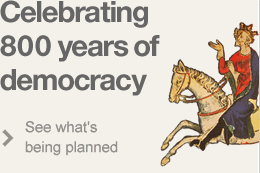John de Lacy, the constable of Chester, was a member of one of the oldest, wealthiest and most important baronial families of twelfth- and thirteenth-century England, with territorial interests distributed widely across the counties of the north Midlands and north.
John (c. 1192-1240) was the eldest son and heir of Roger de Lacy, constable of Chester (d. 1211) and his wife, Maud de Clere. He was a minor at the time of his father’s death and did not enter into possession of his lands until September 1213. Like a number of the rebels, he was a young man at the time that he became involved in the revolt. Although a natural royalism is suggested by his decision to join John on his expedition to Poitou in 1214, he nurtured a sense of grievance against the king owing to the terms on which he was granted possession of his father’s estates. The de Lacy inheritance was a highly valuable one, comprising more than a hundred knights’ fees, together with the baronies of Pontefract (Yorks.), and Clitheroe, Penwortham, Widnes and Halton (Lancs.). John, when he permitted the young heir to enter, therefore exacted his price. He insisted that the latter offer a massive fine of 7000 marks repayable over three years, in the meantime handing over to a royal keeper his chief castles of Pontefract (Yorks.) and Castle Donington (Leics.), to be garrisoned by the king at Lacy’s expense on pain of confiscation should the latter rebel.
As late as the end of May 1215 Lacy was still assumed to be on the king’s side. However, with the fall of London he threw in his lot with the rebels and was present at Runnymede and named to the Twenty Five. Thereafter he veered opportunistically between the rebel and royalist camps. On New Year’s Day 1216 he submitted to the king, agreeing to terms which shed remarkable light on the latter’s own attitude to the Charter imposed on him at Runnymede. Lacy was obliged not only to submit to the king personally but also to renounce the cause for which he had been fighting. In the words of the submission ‘If I have sworn an oath to the king’s enemies, then I will not hold to it, nor will I adhere in any way to the charter of liberties which the lord king has granted in common to the barons of England and which the lord pope has annulled’. Through the imposition of such terms, John was hoping to kill off the charter at birth. Although ostensibly entering into the terms of his own free will, Lacy was probably agreeing to a formula devised by the king’s clerks. Precisely the same wording is found in the charter of submission of Gilbert FitzReinfrey, who likewise made his peace in January 1216.
In May 1216 Lacy was still at the king’s side, but by the time of the latter’s death at Newark in October he was in rebellion again. He was probably active on the rebels’ behalf for much of 1217, but appears not to have been present at the baronial defeat at Lincoln. He submitted and was readmitted to fealty in August, a time when a good many rebels submitted to the new king. In the following month he was ordered to oversee the restoration of Carlisle Castle by the king of Scots. By now, however, his thoughts were now turning to the crusade, and in May 1218 he embarked for Damietta in Egypt with his overlord, Ranulph, earl of Chester. He did not return to England until August 1220. In 1225 he was witness to the definitive reissue of Magna Carta and in the following year he served as a king’s justice in Lincolnshire and Lancashire. Following Ranulph’s death in 1232 he was allowed to inherit one of the earl’s titles, that of the earldom of Lincoln, as the son-in-law of the earl’s sister, Hawise.
Lacy died on 22 July 1240 and was buried near his father in the choir of the Cistercian abbey of Stanlaw (Lancs.), his bones being moved to Whalley, when the monks transferred there in the 1290s. He left a widow, Margaret, daughter of Roger de Quincy (d. 1217), eldest son of Saer de Quincy, earl of Winchester (d. 1219), another of the Twenty Five. Margaret died in 1266 and was buried in the Hospitallers’ church at Clerkenwell, London.
By Professor Nigel Saul, Royal Holloway, University of London.
Featured Article
Today is the very anniversary of the sealing of the Magna Carta, that great charter which laid down the basis for English common law, now spread throughout the world. Magna Carta gave protection of law against despotism by...
Read on...Recent Articles
- Magna Carta's American Adventure
- 800th anniversary of Bristol...
- Bristol 800 concert and...
- Emancipation and Magna Carta
- Terrorism and Tolerance -...
- Magna Carta
- Magna Carta Benches mark...
- ABA Magna Carta Memorial...
Stay updated
If you would like to keep informed about the work of the Magna Carta Trust and our partners, please sign up to the newsletter below.
Become a Supporter
There are a number of significant supporter opportunities. Register your interest early to ensure the widest range of options.
Find out more




